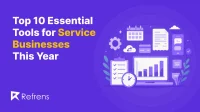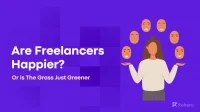Meet Rahul. He is an IT engineer who feels stuck at his 9-5 corporate job. Every day he spends some time browsing social media and sees beautiful workcation pictures that some freelancers and digital nomads post from exotic locations. Rahul feels worse and sulks at his mundane job, wondering if he should jump into freelancing too.
Meet Avni. A fresh college grad still figuring out what to do in life and how to shape her career. Her best friend is a freelance designer, and she earns a lucrative sum of money by working a few hours a day. What’s more, she also has time for her hobbies. Avni is still considering exploring freelancing.
And this is not just the story of Rahul and Avni. The gig economy is booming, and the freelance revolution is starting. While there was already an informal pool of freelancers for a long time, the pandemic and subsequent job losses have pushed more people to embrace freelancing. As per an ASSOCHAM report, “The US leads the race with 53 million independent workers. India has 15 million freelancers with its gig economy workers increasingly gaining independent contracts in industries like IT and programming, finance, HR, and design.”
But freelancing is not all as rosy as it appears to be. It has its share of cons and challenges too. So, if you’re planning to jump on the bandwagon anytime soon, here are some of the freelance realities that no one tells you upfront. Give it a read, and thank us later.
Check out how AI is impacting freelancing
Some Freelance Realities That You Must Know
We spoke to some of the seasoned and newbie freelancers across LinkedIn and Twitter to find out about the freelancing challenges.
- Save before taking the leap: If you’re switching from a full-time job, save money to sustain for at least six months before switching to freelancing. Remember, the first six months to one year is difficult for most entrepreneurs, and freelancing is no different. Save enough to help you last until you gain stability as a freelancer.
Learn financing as a freelancer in this blog.
- Maintaining a steady pipeline of gigs: Like any other business, freelancing needs constant marketing to keep a steady flow of work. Many new freelancers stop marketing their services when they have enough work on their plate. And that’s the biggest mistake they make. Remember, you need to market your services constantly to have a steady pipeline of gigs.
- Direct Messaging is not spamming! When you’re starting, it’s essential to network with people to build connections and generate leads. While LinkedIn and Twitter offer direct messaging facilities, many new freelancers feel embarrassed to reach out to their peers and prospects, thinking they might be spamming. Remember, sending that one message can be a game-changer for you! So, use these features and reach out to people.
- Client retention is the key: Ask any business owner, and they will tell you that it’s easier to retain your old clients than to acquire new customers. In a LinkedIn sales report, 70% of sales professionals said they prioritize customer retention. And this holds for freelancers too. Here are a few things that can help you to stay on top of the game with customer retention
- Make it easier for your clients to work with you
- Be deadline-oriented
- Practice open and transparent communion
- Be flexible and open to feedback
- Learn to say no: Most freelancers, when starting out, tend to say yes to everything a client asks for. They’re afraid that they may lose out on opportunities which can affect their revenues. But remember, you don’t need to say yes to everything — it’s your business, and you set the rules. Have boundaries and stick to them. Don’t be scared to drop off toxic clients — mental peace is equally essential if you want to propel the wheel forward.
Check out the 12 ways to safeguard your mental health as a freelancer.
- Your freelance skill is not enough: Apart from what you freelance in, you also need to be good at marketing your talent, managing cash flow and client relations, keeping track of your finance, and a lot of administrative work that you might not be aware of before jumping in!
Check out the essential soft skills required by a freelancer.
And that’s a wrap!
Hope all these pointers shared by some real-life freelancers will help you make an informed decision. Remember once you carve out a plan for yourself, there’s no stopping you from soaring to success as an established freelancer!
Author Bio
Chayanika is a freelance writer for B2B Tech and SaaS companies. When she’s not writing, you can find her practicing dance lessons, engrossed in a book, or traveling.
Read more: Top Invoicing Software For Consultants


















